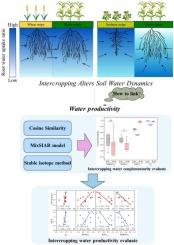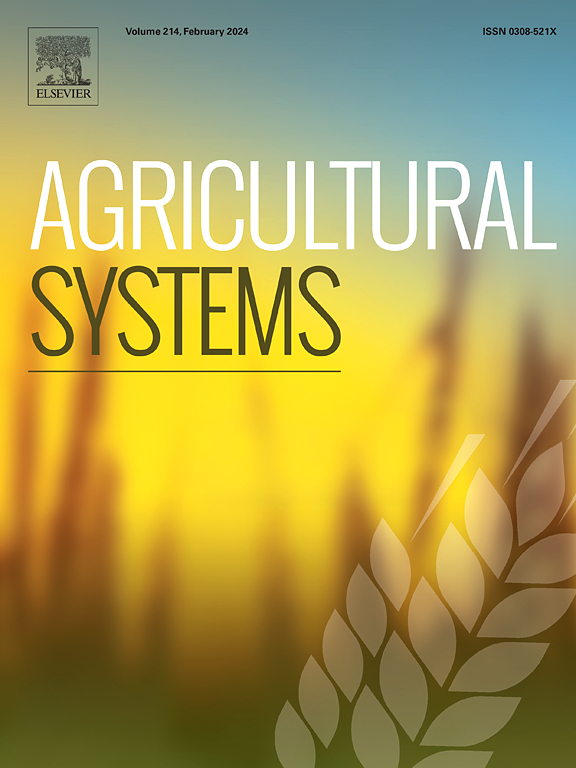Quantifying intercropping water advantages: A novel cosine similarity framework linking root water uptake patterns to productivity
IF 6.1
1区 农林科学
Q1 AGRICULTURE, MULTIDISCIPLINARY
引用次数: 0
Abstract
Context
Intercropping modifies soil water dynamics through complex interspecific interactions crucial for enhancing water productivity. However, quantitative assessment of its productivity based on underlying water utilization processes remains a critical gap. Thus, novel methodologies are needed to evaluate water use patterns-productivity relationships in agricultural systems with interactions.
Objective
This study aimed to develop and validate a novel quantitative framework, using cosine similarity metrics derived from stable isotope data, to evaluate water use complementarity and competition in different intercropping systems.
Methods
Stable isotope combined with the MixSIAR Bayesian mixing model quantified root water uptake (RWU) and differentiated water use strategies. The Relative Difference in RWU (RDRWU) was introduced to quantify water deficits or advantages in intercropping compared to monocultures. Four cosine similarity metrics, θCS, RDSWCS, RWUCS, and RDRWUCS, were proposed linking to water productivity.
Results and conclusions
The cosine similarity metric based on RDRWU (RDRWUCS) demonstrated the strongest linear relationship with water productivity, proving to be a robust and effective indicator for linking intercropping water use complementarity and water productivity.
Significance
The stable isotope method linked with cosine similarity metrics establishes a novel quantitative framework for water utilization patterns in intercropping. They hold significant potential for simulating and optimizing water productivity across irrigation regimes.

量化间作水分优势:一种新的余弦相似框架,将根系水分吸收模式与生产力联系起来
间作通过复杂的种间相互作用改变土壤水分动态,这对提高水分生产力至关重要。然而,根据潜在的水利用过程对其生产力进行定量评估仍然是一个重大差距。因此,需要新的方法来评估相互作用的农业系统中的用水模式-生产力关系。目的利用稳定同位素数据得出的余弦相似度指标,建立并验证一种新的定量框架,以评估不同间作系统水分利用的互补性和竞争性。方法利用稳定同位素结合MixSIAR贝叶斯混合模型定量分析根系水分吸收(RWU)和水分利用策略。引入水分相对差(RDRWU)来量化间作与单作相比的水分亏缺或优势。提出了四个余弦相似度指标θCS、RDSWCS、RWUCS和RDRWUCS与水分生产力的关联。结果与结论基于RDRWU的余弦相似度度量(RDRWUCS)与水分生产力的线性关系最强,是联系间作水分利用互补性与水分生产力的稳健有效指标。意义与余弦相似度指标相结合的稳定同位素方法为间作水分利用模式建立了新的定量框架。它们在模拟和优化跨灌溉制度的水分生产力方面具有巨大潜力。
本文章由计算机程序翻译,如有差异,请以英文原文为准。
求助全文
约1分钟内获得全文
求助全文
来源期刊

Agricultural Systems
农林科学-农业综合
CiteScore
13.30
自引率
7.60%
发文量
174
审稿时长
30 days
期刊介绍:
Agricultural Systems is an international journal that deals with interactions - among the components of agricultural systems, among hierarchical levels of agricultural systems, between agricultural and other land use systems, and between agricultural systems and their natural, social and economic environments.
The scope includes the development and application of systems analysis methodologies in the following areas:
Systems approaches in the sustainable intensification of agriculture; pathways for sustainable intensification; crop-livestock integration; farm-level resource allocation; quantification of benefits and trade-offs at farm to landscape levels; integrative, participatory and dynamic modelling approaches for qualitative and quantitative assessments of agricultural systems and decision making;
The interactions between agricultural and non-agricultural landscapes; the multiple services of agricultural systems; food security and the environment;
Global change and adaptation science; transformational adaptations as driven by changes in climate, policy, values and attitudes influencing the design of farming systems;
Development and application of farming systems design tools and methods for impact, scenario and case study analysis; managing the complexities of dynamic agricultural systems; innovation systems and multi stakeholder arrangements that support or promote change and (or) inform policy decisions.
 求助内容:
求助内容: 应助结果提醒方式:
应助结果提醒方式:


